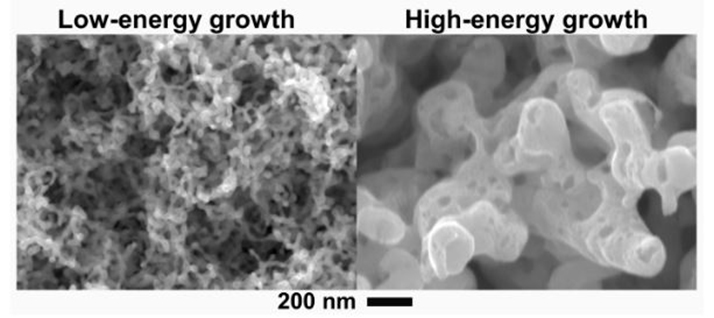Understanding Tungsten “Fuzz”
New work seeks to explain a strange phenomenon occurring in fusion reactor materials.

Image courtesy of Oak Ridge National Laboratory
The Science
When exposed to energetic helium bombardment as in the plasma-facing components of fusion devices, tungsten will grow a mat of “fuzz.” The fuzz is typically a few tens of nanometers in diameter and up to several microns in length. For comparison, a strand of human DNA is 2.5 nanometers in diameter and a red blood cell is 5 microns wide. Generally, the detailed mechanisms of growth and structure of these tendrils are not well understood. In this study, researchers grew tungsten “fuzz” and characterized it at a number of conditions. Their results help to validate and inform models and theoretical understanding.
The Impact
Tungsten “fuzz” is likely to have both beneficial and detrimental properties in terms of overall materials performance for fusion reactors. On the plus side, fuzzy tungsten is expected to take heat loads that would crack bulk tungsten. Also, erosion is orders of magnitudes less in fuzzy than in bulk tungsten. On the minus side, the fuzz, or nanotendrils, are fragile. They can break off, forming a dust that can cool the plasma. Until more is known about the tungsten fuzz, engineering these materials to eliminate the bad while accentuating the good is impossible. With this in mind, the researchers focused on understanding the fundamental behavior and degradation mechanisms of these plasma-facing materials. The ultimate goal is designing more robust materials for service in the harsh fusion environment.
Summary
Under helium plasma exposure in tokamak-relevant conditions, nanotendril “fuzz” will grow on tungsten plasma-facing components in a magnetic fusion energy device. Researchers at Oak Ridge National Laboratory, in conjunction with collaborators, have grown tungsten nanotendrils at varying helium bombardment energies and characterized them using electron microscopy. The scientists showed that exposure to both low and high-energy helium plasmas form narrow grass-like mats of tendrils. Tendrils grown under lower energy bombardment are both finer and smoother than those grown under high-energy bombardment. Additionally, the team showed that both families of tendrils are nanocrystalline with fine-scale cavities, believed to be helium bubbles, just a few nanometers in size. Finally, the team used electron diffraction to perform crystallographic mapping of the grains to gain insight into growth mechanisms of the fuzz. Although they observed no preferential growth axes or angles/axis pairs, patterns did emerge that indicate differing growth mechanisms depending on helium bombardment energy. Although the details of these mechanisms remain unresolved, the results presented here indicate engineering solutions to the amelioration of nanotendril growth, or surface degradation in general, will need to address multiple mechanisms of degradation.
Contact
Dr. Chad M. Parish
Oak Ridge National Laboratory
parishcm@ornl.gov
Funding
This work was primarily supported by an Early Career Award, U.S. Department of Energy (DOE), Office of Science, Fusion Energy Sciences, under contract DE-AC05-00OR22725. Additional support was provided by the Laboratory Directed Research and Development Program of Oak Ridge National Laboratory, managed by UT-Battelle, LLC, for DOE. Instrumentation support was provided by DOE, Office of Nuclear Energy, Fuel Cycle Research and Development Program and the Nuclear Science User Facilities.
Publications
K. Wang, R.P. Doerner, M.J. Baldwin, F.W. Meyer, M.E. Bannister, A. Darbal, R. Stroud, and C.M. Parish, “Morphologies of tungsten nanotendrils grown under helium exposure.” Scientific Reports 7, 42315 (2017). [DOI: 10.1038/srep42315]
K. Wang, M.E. Bannister, F.W. Meyer, and C.M. Parish, “Effect of starting microstructure on helium plasma-materials interactions in tungsten.” Acta Materialia 124, 556-567 (2017). [DOI: 10.1016/j.actamat.2016.11.042]
C.M. Parish, K. Wang, R.P. Doerner, and M.J. Baldwin, “Grain orientations and grain boundaries in tungsten nanotendril fuzz grown under divertor-like conditions.” Scripta Materialia 127, 132-135 (2017). [DOI: 10.1016/j.scriptamat.2016.09.018]
Related Links
Oak Ridge National Laboratory highlight: ORNL study examines tungsten in extreme environments to improve fusion materials
Highlight Categories
Program: FES
Performer: University , DOE Laboratory
Additional: Collaborations , NE



